ACCUSED HEAR VERDICT IN MALMEDY MASSACRE TRIAL
Dachau, Germany • July 16, 1946
On this date in 1946, at the former Nazi concentration camp in Dachau about 20 miles northwest of the Bavarian capital of Munich, a U.S. military tribunal convicted all 73 men on trial in the Malmedy Massacre case; 43 were sentenced to death by hanging and the rest were given long prison sentences. Known collectively as “the Dachau trials”—there were 489 proceedings conducted in Dachau between November 15, 1945, and 1948—the American military tribunals at Dachau are not to be confused with the proceedings against the major German war criminals before the four-power International Military Tribunal at Nuremberg.
At Dachau a panel of eight high-ranking U.S. Army officers acted as judge and jury in a manner similar to a U.S. Army court martial. Convictions required a two-thirds majority of panel members. Attorneys for the defense were also American army officers. The prosecution did not need to prove the accused guilty of charges. During pre-trial investigations their guilt had been established by interrogators tasked with obtaining confessions from the defendants, who were then of course presumed guilty. Hearsay testimony was allowed by the court. Witnesses who submitted affidavits but did not appear in person could not be subpoenaed and cross-examined. Some of the accused were not permitted to testify in their own defense. Indeed, the defense encouraged most of the accused not to testify. Thus the outcome of any of the Dachau trials was never in doubt.
The Malmedy Massacre proceedings (Case Number 6-24)—the most famous of the Dachau trials—focused primarily on the grisly killing of 84 out of perhaps 125 American soldiers who had surrendered on December 17, 1944, one day after Adolf Hitler had launched a furious offensive in the Ardennes Forest of Belgium and Luxembourg aimed a punching a hole in Allied lines, an offensive popularly known as the Battle of the Bulge. The disarmed soldiers had surrendered to a unit of the Waffen-SS (the military arm of Adolf Hitler’s Nazi Party) at the Baugnez road crossing 2‑1/2 miles south of Malmedy in Eastern Belgium. More than 30 Americans survived the slaughter to tell about it. The accused war criminals in the Dachau courtroom included former Schutzstaffel (SS) Gen. Josef “Sepp” Dietrich, commander of the German Sixth Panzer Army and Lt. Col. “Jochen” (Joachim) Peiper, then a 29‑year-old SS officer commanding Kampfgruppe Peiper, the 5,000-strong armored battle group that spearheaded the German Ardennes offensive. It was a small cadre of SS panzergrenadiers left by Peiper to “guard” the Americans in a field beside the Ligneuville–St. Vith road at Baugnez who murdered their charges in cold blood after shouting, as survivors testified, “Macht alle kaputt.”
Besides the casual killing of disarmed American soldiers at the Baugnez road crossing, the 73 SS men standing trial at Dachau were accused of murdering additional POWs (between 538 and 749 in all) and hundreds of Belgian civilians whom the Germans claimed had aided the Allies or had engaged in partisan attacks; few claims had a basis in truth. On the same day as the Baugnez-Malmedy slaughter, Peiper’s SS panzergrenadiers executed 19 American POWs in a field near Honsfeld; two villagers who were made to face a wall were shot in the back of the head. In the fighting in and around Stavelot southwest of Malmedy shortly after the German offensive began, Peiper’s panzergrenadiers killed more than 130 civilians, mostly women and children, the men having fled west to safety. Practically everywhere in the war-ravaged Ardennes, one and a half months of intense fighting reached a savagery similar to that on the Eastern Front, where horrific violence such as that lasted five long years.
The Malmedy Massacre Trial at Dachau, Germany, May–July 1946
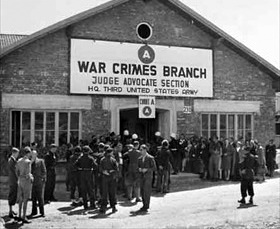 | 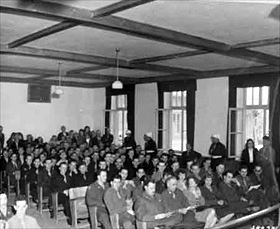 |
Above: The Dachau courthouse (left frame) and courtroom (right frame) where the Malmedy case, officially known as U.S. vs. Valentin Bersin, et al., was tried. The U.S. military selected Dachau for its German war crimes proceedings, in part for the abundant housing available at the former concentration camp and the large SS training camp there, and in part because the site was most associated in the minds of the American public with German atrocities in World War II. The Malmedy Massacre proceedings began on May 12, 1946, and the verdicts were handed down on July 16, 1946. The proceedings captured media headlines and were filmed; scenes were shown in newsreels in American theaters.
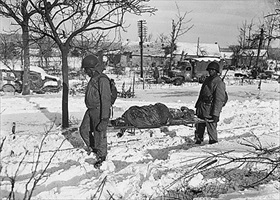 | 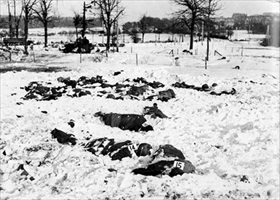 |
Above: These photographs taken in mid-January 1945 show some of the 72 bodies that were recovered on January 14 and 15, 1945, after laying under 2 feet of Belgian snow four weeks after their murder. Another 12 bodies were recovered 4 months later following snowmelt, making a total of 84 victims. Some Germans testified that the American prisoners, lightly armed members of Battery B of the 285th Field Artillery Observation Battalion, which had just departed Malmedy, tried to escape or had recovered weapons and fired on their captors. However, detailed autopsies by U.S. Army surgeons revealed that at least 20 victims had suffered fatal gunshot wounds to the head or neck, inflicted at point-blank range, which left powder burns. These bullet wounds were in addition to those made by automatic weapons fired from a distance. Another 20 victims showed evidence of small-calibre gunshot wounds to the head without powder-burn residue. Another 10 had fatal crushing or blunt-trauma injuries, most likely from rifle butts. Some bodies showed only one wound in the temple or behind the ear. To shoot unarmed prisoners was prohibited by secular international law (Hague Conventions of 1899 and 1907). But to machine gun prisoners and then methodically, heartlessly, and laughingly (per the testimony of three survivors who feigned death) move among the dead and dying with hand guns to finish off anyone still showing signs of life, stripping the victims of dog tags, wallets and watches—that was considered an unspeakable atrocity.
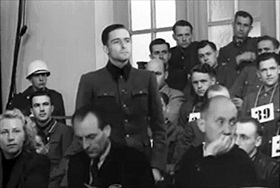 | 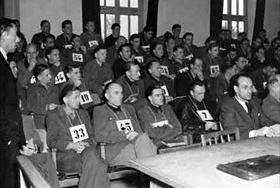 |
Left: Accused war criminal Joachim Peiper (center), Dachau 1946. The leader of Kampfgruppe Peiper and many of his SS panzergrenadiers were brought to trial for their killing frenzy in Belgium during the German Ardennes Offensive in December 1944 and January 1945. Over 300 Americans and Belgians were murdered by Kampfgruppe Peiper. The weight of historical evidence in the December 17, 1944, incident near Malmedy is that Peiper made a battlefield decision, ordering the execution of American prisoners based on his armored unit’s assignment to capture the bridge over the Meuse River in the Belgian town of Huy and hold it until SS Gen. Dietrich’s Sixth Panzer Army could cross over it. Heavy American artillery fire forced Peiper to take an alternate route through the tiny village of Malmedy. Doubtless Peiper factored in the difficulty of evacuating large numbers of captured men with little available infantry without it threatening the momentum of his striking spearhead. Peiper himself departed what became the execution site. Making the decision easier on the few panzergrenadiers Peiper left nervously holding the captives was the ethos Peiper’s men had acquired fighting in Italy and on the Eastern Front, where they showed how little they valued an enemy’s life. With despicable ruthlessness and brutality, Peiper’s men took pride in their unit’s nickname, the “Blowtorch Battalion,” because of its penchant for setting fire to every building it could and burning to death every man, woman, and child inside.
![]()
Right: Defendants at the Malmedy Massacre trial listen to closing arguments. Peiper sits with crossed arms in the front row. After deliberating less than 2‑1/2 hours, the court handed down 43 death sentences as well as prison terms of 10, 15, and 20 years to life. SS Gen. Sepp Dietrich (obscured by figure on left) was sentenced to life in prison along with 21 other men. SS Gen. Fritz Kraemer (33) was sentenced to 10 years in prison and SS Lt. Gen. Hermann Priess (45), Peiper’s corps commander, was sentenced to life, subsequently commuted to 20 years. Peiper was condemned to death for his part in the massacre, although no direct evidence was presented at the proceedings that he had ordered the killings. Ultimately not one of those sentenced to death was executed, and none served a full prison sentence after evidence of procedural irregularities surfaced. Last to be released from prison was Peiper in December 1956, having served a little over 11 years, the same number of years he had served in Hitler’s armed forces. Following his release Peiper pursued a career in the auto industry in West Germany, employed for a time by Porsche and a Volkswagen dealership. But Peiper’s wartime past followed him everywhere. “I was a Nazi and I remain one,” he told a French writer in 1967. Eventually he and his wife settled in a house they had built near Traves in Eastern France. On July 14 (Bastille Day), 1976, his ill deeds caught up with him when unknown assailants (quite possibly veterans of the French Resistance) attacked his house with firebombs, killing him but not his wife who was not home.
Contemporary German and U.S. Newsreels Recount Malmedy Massacre and Trial, 1945–1946. WARNING: Some graphic images
![]()

 History buffs, there is good news! The Daily Chronicles of World War II is now available as an ebook for $4.99 on Amazon.com. Containing a year’s worth of dated entries from this website, the ebook brings the story of this tumultuous era to life in a compelling, authoritative, and succinct manner. Featuring inventive navigation aids, the ebook enables readers to instantly move forward or backward by month and date to different dated entries. Simple and elegant! Click
History buffs, there is good news! The Daily Chronicles of World War II is now available as an ebook for $4.99 on Amazon.com. Containing a year’s worth of dated entries from this website, the ebook brings the story of this tumultuous era to life in a compelling, authoritative, and succinct manner. Featuring inventive navigation aids, the ebook enables readers to instantly move forward or backward by month and date to different dated entries. Simple and elegant! Click 











